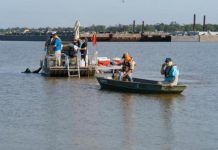
CHICAGO, Dec. 21 (UPI) — Researchers have released a new map showcasing concentrations of polyhalogenated carbazoles, a new class of toxic chemicals, in Great Lakes sediment.
Analysis of sediment samples from Lakes Michigan, Superior and Huron suggest a total of 3,000 tons of PHCZs are distributed among the three. Not all of it is pollution, however.
“Because the amount of PHCZs we found is so high, and because of their location in the lakes as well as in the sediment cores we took, we believe that most of the PHCZs in these lakes is the result of natural processes,” An Li, a professor of environmental and occupational health sciences at the University of Illinois, Chicago, said in a news release. “However, we see some PHCZs in sediment laid down in more recent years, which is very likely from man-made sources. These are considered chemicals of emerging concern and should be monitored carefully.”
PHCZs are dioxin-like compounds, highly toxic and persistent in the environment. They’ve been linked with developmental defects, embryonic disruption and some cancers.
In the newly published map, researchers classified the compounds according to where they were found in lakebed sediment cores.
Category 1 PHCZs are those found in the deepest portions of the lake and at the bottom of sediment cores. Scientists suggest their presence is largely explained by natural processes such as the chemical breakdown of organic matter.
Category 2 PHCZs aren’t as abundant — an estimated 130 tons in the upper Great Lakes — but are found at shallower layers. Their distribution is similar to the distribution of other types of man-made pollution, like polychlorinated biphenyl compounds, or PCBs.
Scientists published the map in the journal Environmental Science and Technology.






